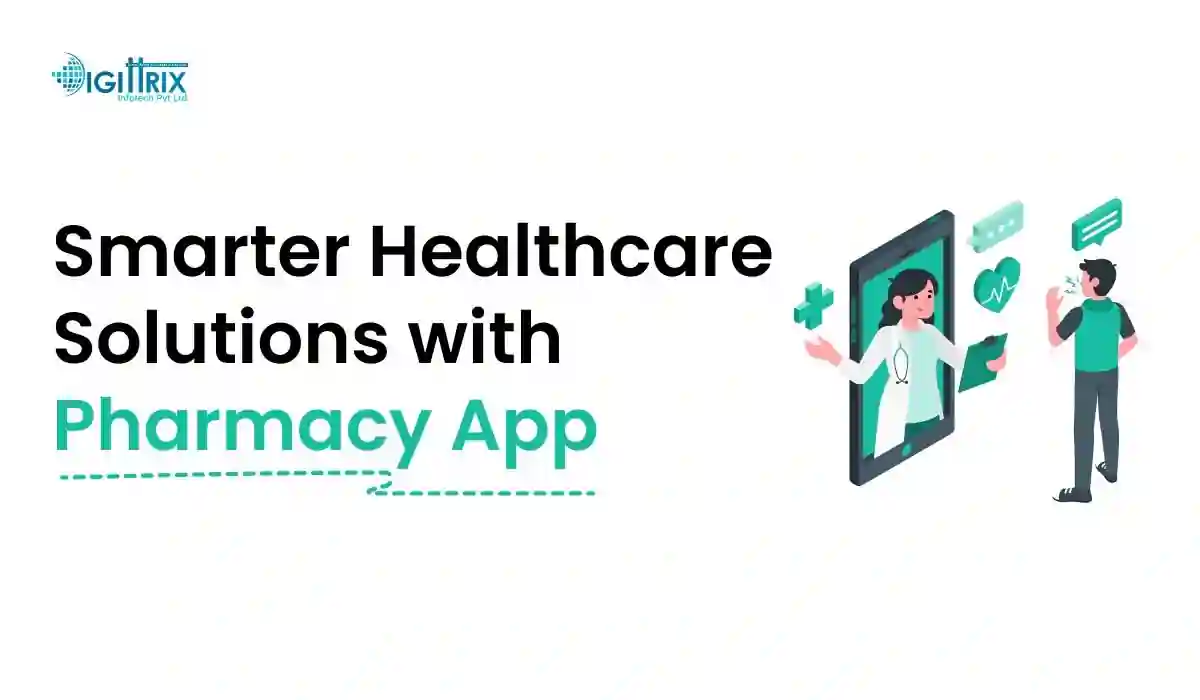The global online pharmacy market is projected to grow significantly, reaching $131.3 billion by 2025, fueled by increasing demand for convenient healthcare solutions.
Highlights
With Over 14 years of Experience in the IT Field, Helping Companies Optimise there Products for more Conversions

In recent years, the way people purchase medicines and manage their health has changed significantly. More customers now prefer digital solutions that allow them to order medications, track prescriptions, and access pharmacy services from the comfort of their homes. By 2025, this shift is expected to increase further, making pharmacy app development a priority for businesses in the healthcare sector.
Developing a smart pharmacy app involves more than simply creating an online store for medicines. It requires careful planning, the integration of useful features, compliance with healthcare regulations, and a good understanding of user needs. This article discusses practical steps and best practices for building a smart pharmacy app in 2025, including key technologies, must-have features, and development strategies. GlobeNewsWire reports show that the online pharmacy market is expected to grow at a CAGR of 18.4% by 2025.
Want to build a pharmacy delivery app like Apollo? Read our expert guide to get started the right way!
As healthcare becomes more digital, users are looking for convenient ways to access medical support. A pharmacy app helps meet this demand by allowing people to:
For pharmacy owners, a smart app provides a new way to serve customers, reduce foot traffic during busy hours, and handle inventory efficiently.
With 5G networks, smart wearables, and secure payment systems gaining popularity, 2025 is an ideal time to invest in mobile app development for pharmacy solutions. Apps like Netmeds, Apollo, 1mg, and Medibuddy have already set high expectations for the industry, and you can create something just as impactful with the right approach.
A successful pharmacy app should meet the basic needs of users while also offering extra convenience. Here are some key features to include:
Allow users to register using their email or phone number. Including social media logins or biometric authentication options can also enhance user convenience and security.
Include a search bar with smart suggestions. Filters based on category, brand, price, and type (tablet, syrup, injection) help users find what they need quickly. Integrating a feature for searching generic medicines can provide users with more affordable alternatives, similar to platforms like GeniusRx or Boots.
Users should be able to upload their prescriptions using their phone's camera or gallery. The system can either approve them automatically using OCR (Optical Character Recognition) or forward them to a pharmacist for manual review.
Integrate chat or video call support with pharmacists or doctors. This helps customers receive advice on medicine usage, dosage, and possible substitutes. Many users may want to order prescription-based products from reputable pharmacies like Pharmacystore, Carezone, or Caring Pharmacy.
Provide a straightforward cart system and secure payment options. Support for UPI, cards, net banking, and wallets is essential, similar to how Dunzo and Postmates facilitate payments for on-demand services.
Real-time order tracking builds trust. A delivery dashboard featuring estimated times, status updates, and delivery personnel details adds value. Whether you collaborate with services like Grofresh, Dvago, or Cashway, effective delivery management systems are essential.
Allow users to subscribe to regular medication refills so they don't have to place an order manually each time. This feature is especially beneficial for users of chronic medications, making apps like Medimpact highly effective in this segment.
Send alerts for prescription reminders, order confirmations, offers, and delivery updates. Integrate platforms like WhatsApp or Telegram to send such notifications for easier communication.
Allow customers to rate products and services. This fosters credibility and assists other users. It also enhances the overall reputation of your app, similar to how users rate medicines on platforms like Amazon or iPharmacy.
Admins should have access to inventory details, user orders, payments, and reports through a secure backend panel. Integrating blockchain technology for secure tracking of inventory can further enhance transparency and trust, similar to the systems used by Apothecary and other health brands.
To develop a smart and efficient pharmacy app, picking the right technology stack is important. Here's a suggested stack for different parts of the application:
You may also consider hiring Android app developers or iOS app developers if you’re planning to launch separate native versions of your pharmacy app. Additionally, integrating IoT or healthcare apps such as Carezone can further enhance functionalities. A survey by Statista reveals that 62% of consumers prefer ordering prescriptions online for convenience and cost savings.
Building a pharmacy app involves a detailed process that should be followed step by step. Below is a breakdown of how you can go about it:
Begin by understanding the target market. Analyse existing pharmacy apps to identify what works and what doesn’t. Define your app's goals, target audience, and key differentiators. Consider whether you want to partner with larger platforms like Guardian Pharmacy or develop a more niche app similar to Belshifa.
Create wireframes that illustrate how the app will look and function. Focus on ensuring simple navigation. Use large fonts, clear labels, and easy-to-press buttons, especially if elderly users are part of your audience. Collaborate with medical UI experts to design an accessible interface, similar to Medibuddy and MediCap.
Once designs are finalized, the development work begins. This is when you start coding the frontend and backend. It's often beneficial to partner with a company that provides custom healthcare software development for enhanced industry knowledge and guidance. Apps like Frank Pharmacy have been developed with careful attention to medical compliance.
This step involves incorporating third-party APIs for features such as payment processing, order tracking, delivery management, or medical information. Thoroughly test all integrations to prevent data errors or app crashes. Consider companies like ASHP for pharmaceutical API integrations or collaborate with medical software providers like LloydsDirect.
Once development is complete, test the app on multiple devices and platforms. Employ both manual testing and automated tools to assess performance, security, and usability. Resolve all bugs before the launch. Remember to conduct beta testing with caregivers or pharmacists to obtain real-world feedback.
Submit the app to Google Play Store and Apple App Store. Promote your app using ads, referrals, or by collaborating with local clinics. Encourage users to provide feedback and fix early issues quickly. Platforms like Apothecary and BSP already have a head start in this area.
Since pharmacy apps deal with health data and prescriptions, legal compliance is very important. You must:
In countries like India, pharmacy app operators are required to register under the Drugs and Cosmetics Act, and only approved pharmacists can process medicine requests. Platforms such as Davaindia and Medbuzz strictly adhere to these regulations.
Developing a pharmacy app is a specialized task. Selecting the right development partner can simplify the process. Seek out companies with experience in creating healthcare apps.
They should offer:
Additionally, confirm whether they provide ongoing testing, performance checks, and support to address any technical issues that may arise after launch.
The cost of developing a smart pharmacy app in 2025 depends on several factors:
On average, a basic pharmacy app can cost between USD 10,000 and USD 30,000 (INR 8,55,000 - INR 25,64,000), while feature-rich apps with advanced APIs and real-time tracking may cost up to USD 60,000 or more (INR 51,28,000 or more).
If you want to reduce costs, you can start with a Minimum Viable Product (MVP), which includes core features. Once the app gains users, you can add more features gradually.
Smart pharmacy apps handle sensitive health data, so security should not be ignored. Important security measures include:
Hiring a team skilled in healthcare app development services will help you maintain app safety and user trust. According to Statista, 35% of US adults have used telemedicine services, including online pharmacy orders and consultations.
Building a pharmacy app in 2025 can help you reach more customers and conveniently offer healthcare services. However, it requires careful planning, knowledge of healthcare regulations, and the selection of appropriate features and technologies. By focusing on user needs, data security, and compliance with legal standards, your app can provide value to users and become a trusted part of their health routine. Whether you want to start from scratch or need expert help, finding the right team to develop a pharmacy app will be your first significant step in this journey.
Developing a smart pharmacy app in 2025 goes beyond just online medicine delivery, it's about integrating real-time order tracking, secure prescription uploads, telemedicine, and Iot-enabled medical device support into one seamless user experience.
At Digittrix, we specialize in custom pharmacy app development that’s built to scale. With over 14 years of experience in healthcare, mHealth, and e-commerce app development, we help businesses integrate features like insurance compatibility, FDA-compliant electronic prescriptions, blockchain for data security, and Flutter/iOS/Android support.
Looking to launch your smart pharmacy app like AllianceRx, Brookshire’s, BSP, BGC, or Guardian? Let us help you create an app that truly stands out in a competitive market. Call us today at +91 8727000867 to speak with a technical manager or ???? email us at digittrix@gmail.com.
Let Digittrix help you build a smart pharmacy app that is secure, innovative, and future-ready.

Do you need help in Health Care App Development ?




Join over 1500+ businesses we've already helped!
A smart pharmacy app should include features like user registration, medicine search, prescription upload, online consultations, order tracking, subscription for repeat orders, and secure payment methods.
Technologies such as React Native or Flutter for the frontend, Node.js for the backend, and PostgreSQL or MongoDB for the database are commonly used. Integration with APIs for payment and delivery management is also essential.
Ensure the security of your pharmacy app by using end-to-end encryption, two-factor authentication, role-based access, and conducting regular security audits.
Yes, a pharmacy app can offer on-demand delivery by integrating features like real-time tracking, geo-location services, and fast order processing to deliver medicines within hours.

©2025Digittrix Infotech Private Limited , All rights reserved.